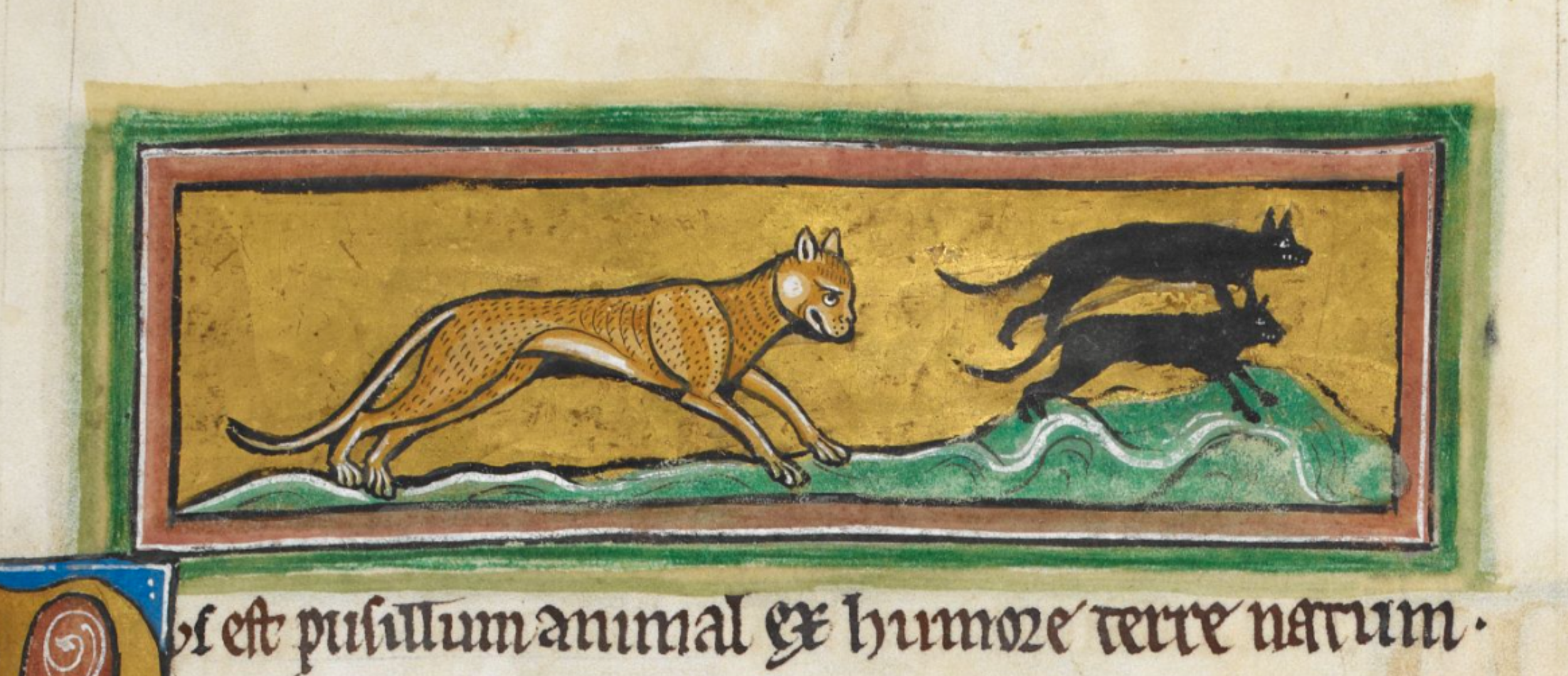
Cat, Rochester Bestiary, c.1230
Search page
Search within this page here, search the collection page or search the website.
Index
Horse, Rochester Bestiary, c.1230
Mouse, Rochester Bestiary, c.1230
Cat, Rochester Bestiary, c.1230
In the enchanting realm of feline lore, the cat reigns supreme with its mystique and cunning nature. Known by various names, each hinting at its prowess and demeanour, the cat holds a special place in human imagination.
The Latin term musio hints at its ancient rivalry with mice, embodying its role as a relentless hunter in the rodent kingdom. Yet, it is the moniker căttus that truly captures the essence of this enigmatic creature. Derived from captūra, evoking images of stealth and precision, the cat is the epitome of a skilled predator, effortlessly ensnaring its prey.

By delving deeper into the etymology, you will uncover a subtler narrative. Some suggest that cătus derives from captat, highlighting the feline's acute senses and piercing gaze. With eyes that pierce through the darkness of night, the cat navigates its domain with an astuteness that borders on the supernatural.
F42v
vulgus catum a captura vocant. Alii dicunt
quod cattat id est videt. Nam in tanto acumine cernit;
ut fulgore luminis; tenebras noctis superet. Unde
a greco venit catus. idest ingeniosus.
The cat is called musio, for it is hostile to mice. It is commonly called căttus from captūra, catching or prey. Others say that the word comes from captat that is, it senses, for its sight is so sharp that it is able to prevail over the darkness of the night owing to its glowing eyes. Hence, the word cătus comes from Greek and means meaning astute, cunning.
Bibliography
David Badke, The Bestiary Blog: Animals in the Middle Ages, Cat, November 6 2023, https://bestiary.ca/beasts/beast213.htm
Josh Goldenberg (BA 2012) and Matt Shanahan (BA 2014), Logeion, November 2022, https://logeion.uchicago.edu/
Castiglioni, L. and Mariotti, S. (1996). Vocabolario della Lingua Latina: Latino-Italiano Italiano-Latino. Terza Edizione. Loescher Torino
Matthews, J. and Matthews C., (2010), The Element Encyclopedia of Magical Creatures, HarperCollins UK, London
Curley, M. J., Physiologus: A Medieval Book of Nature Lore (University of Chicago edition 2009)
Rackham, H., M.A., Pliny Natural History Volume III, Libri VIII-XI (London: William Heinemann Ltd, 1949)
Collins, A. H., M.A., Symbolism of Animals and Birds (New York: McBride, Nast & Company, 1913)
Henderson, C., The Book of Barely Imagined Beings (London: University of Chicago Press, 2013)
White, T. H., The Bestiary: A Book of Beasts (New York: G.P Putnam’s Sons, 1960)
Barney, S. A., Lewis, W. J., Beach A., Berghof O., The Etymologies of Isidore of Seville (New York: Cambridge University Press, 2006)
